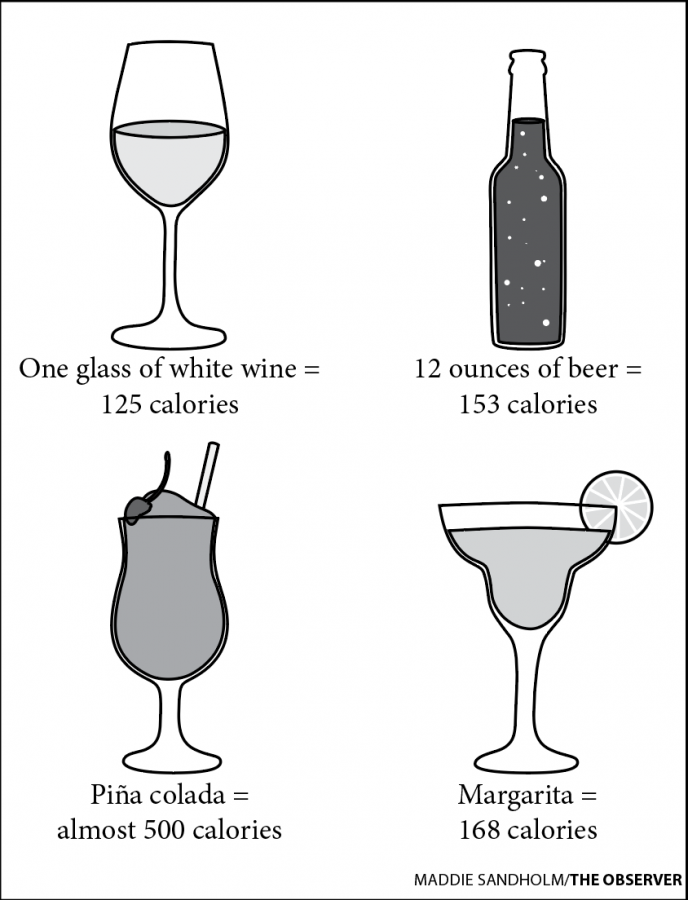Booze Won’t Help You Lose
Nutrition labels may not be provided on alcoholic drinks, but that doesn’t mean the calories don’t count
January 22, 2020
AlcoholEdu stresses drinking responsibility, but the creators of this educational module focus on blood alcohol content and the factors that can exacerbate alcohol’s effects on the brain. Though AlcoholEdu exhaustively highlights how alcohol affects us while we are drinking it, the program ignores one major way alcohol can impact us in the long term. That is, alcohol — from wine to tequila — is packed with calories.
To put the number of calories into perspective, the 2015 to 2020 Dietary Guidelines for Americans states that a standard alcoholic beverage contains 14 grams of pure alcohol, which contributes 98 calories to the drink. Other ingredients in the specific type of alcoholic drink will add to the total number of calories. According to the National Institute on Alcohol Abuse and Alcoholism (NIAAA), a glass (eight ounces) of white wine will generally contain 125 calories, whereas 12 ounces of beer has 153 calories. On top of the alcohol, mixers can add even more calories to the drink. A piña colada, for instance, has almost 500 calories, which largely come from the pineapple juice and coconut cream.
It may not come as a surprise that drinking a glass of wine might be on par calorically with a bottle of Coca Cola, but it’s hard to account for such calories when most alcoholic beverages are missing a nutrition label. Alcohol does not fall under the supervision of the Food and Drug Administration (FDA); rather, the Alcohol and Tobacco Tax and Trade Bureau regulates alcohol sales and consumption and does not require alcohol companies to place nutrition labels on their products. The FDA can regulate products with 7% or less alcohol content, which is why drinks like spiked seltzers have nutrition labels.
What’s more, the amount of alcohol and the calories that come with it are especially difficult to discern when purchasing alcoholic beverages in a bar setting or preparing them on your own at home. It is not standard practice for bars to list the calories in their drinks, and the amount of alcohol in a specific type of drink may vary each time bartenders make them.
Of the 80% of college students who drink, it’s estimated that 50% engage in binge drinking, which is consuming more than four to five calorie-rich drinks in a two-hour period. For example, four margaritas, at 168 calories per drink, can contribute 672 extra calories to your caloric intake that day. Overdrinking on a weekly basis could make it more difficult to control weight gain, which would coincide with the other health problems associated with alcohol.
According to the 2015 to 2020 Dietary Guidelines for Americans, drinking in moderation means only having up to one drink per day for women and two drinks for men. Nutrition labels on alcohol bottles still seems far off from becoming a reality, so along with consuming alcohol in moderation, the NIAAA has an Alcohol Calorie Calculator that can give you a rough estimate of the additional calories alcoholic drinks provide.
Meticulously counting calories is not a realistic practice and becomes even more difficult in social situations. However, keeping basic nutritional factors in mind could make for a healthier night. Alcohol content may have a more immediate effect, but high calorie counts can have long-term consequences.












Ian • Feb 21, 2020 at 10:01 am
Alright so I’m a little late to the party, but I’ve got some things to say. Calories and alcohol have a relationship that’s a bit more complex than what this article may suggest. First of all, a calorie is a measure of energy. That seems like a no-brainer, but what people might not realize is that calories are not a measure of how our bodies are able to utilize the energy that a calorie measures. A gallon of gasoline, for example, has something like 30,000 calories. Does this mean drinking a gallon of gas will make you gain weight? Of course not. Gasoline is poisonous to people, and drinking it would kill you. Now put down that jerry can.
The same, to an extent, is true of alcohol. We all know (thanks to programs like AlcoholEdu) that alcohol in high enough volumes can kill a person, and that repeated consumption of alcohol damages internal organs. Shoutout Mt. Sinai. What’s more, as with gasoline, your body cannot utilize alcohol the same way it utilizes the nutrients and macromolecules (proteins, lipids, carbohydrates) found in foods and beverages. But even though alcohol contains no nutritional value, it’s packed with energy. Anybody who’s seen a flaming shot can attest to this. As a result, the calorie count of alcohol is crazy high when compared to other beverages, but the nutritional value is next to nothing.
The best example I’ve seen of this comes on the nutritional label for Captain Morgan spiced rum. On the back of the bottle, it says that in 1.5 ounces (a shot) of the rum there’s a whopping 86 calories. Immediately after that, the carbohydrate, fat, protein, etc. content is listed. Aside from half a gram of carbohydrates, there is no other nutritionally relevant macromolecule present in a shot of rum. So, does this mean there’s 86 calories in just that half-gram of carbohydrates? No, not even close. If you look at the USDA’s website, carbohydrates are listed at four (4!) calories a gram. That means that in the half gram of carbs in a shot of rum, there’d be a whole two calories that your body could actually use, probably added into the alcohol and water during whatever process “spices” spiced rum. Those other 84 calories come from (you guessed it!) energy-rich but nutritionally useless alcohol molecules.
I don’t mean to discount the numerous ways in which drinking may cause weight gain. Sugary mixers abound, as do poor nutritional decisions made while under the influence. Drinks like beer and Four Loko are loaded with carbs that your body most definitely can and will convert into fat, and crushing two krunk bags of spicy Doritos probably aren’t too good for you either. But if this article is arguing for more nuance in programs like AlcoholEdu, then I think it’s a disservice to people not to mention the deceptive way in which alcohol appears to be loaded with calories.